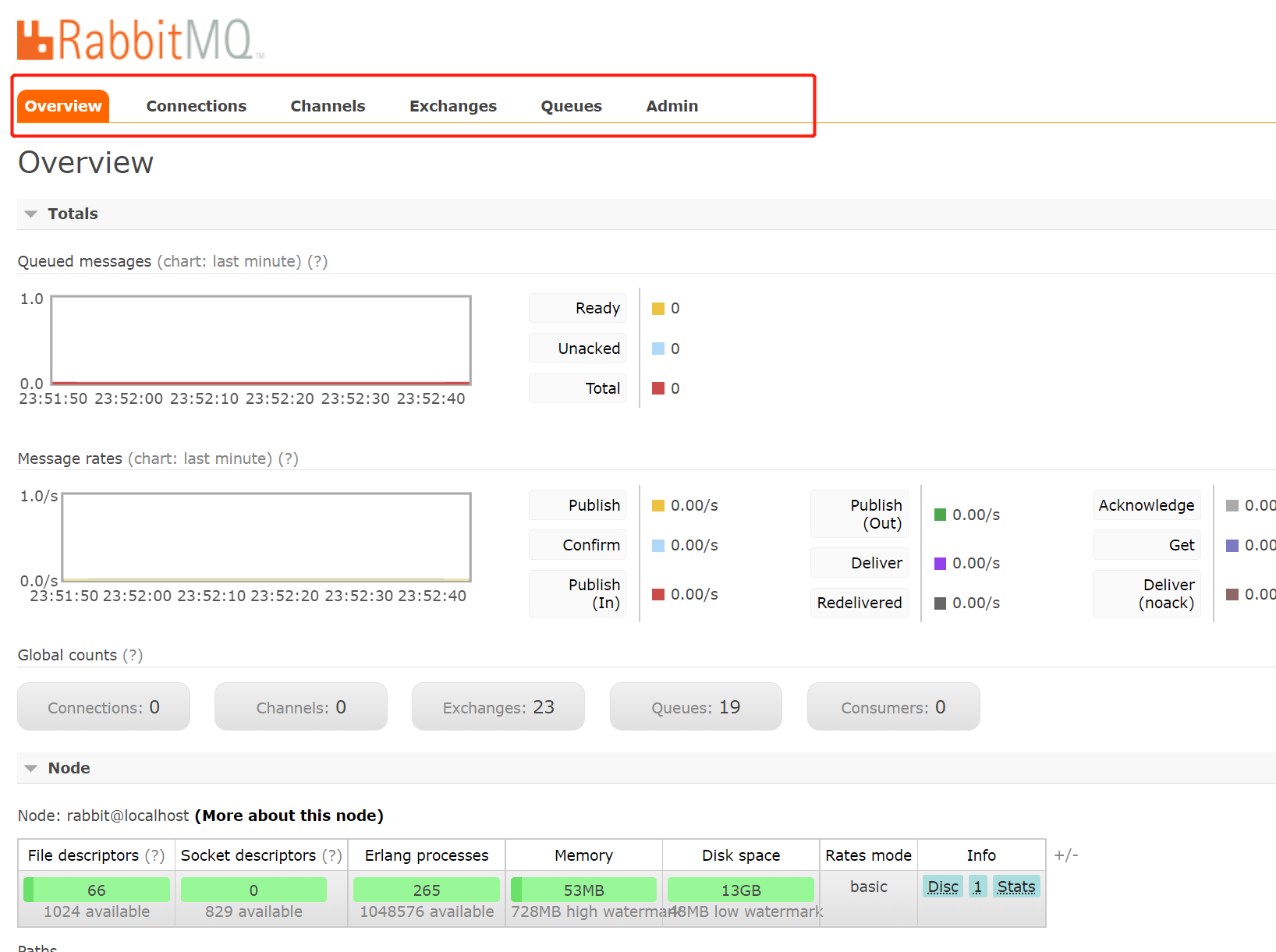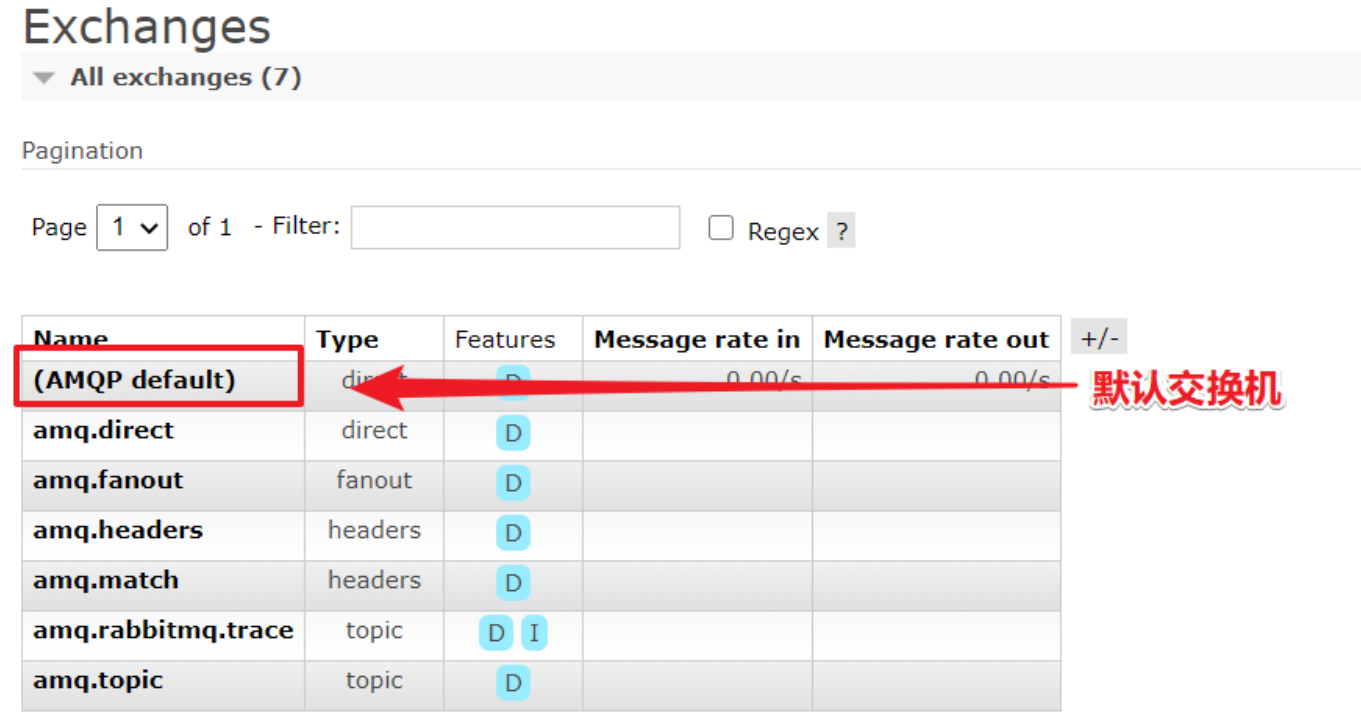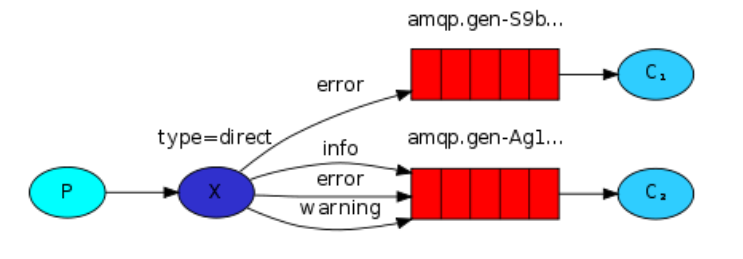RabbitMQ
一、什么是 RabbitMQ
RabbitMQ是一个开源的遵循AMQP协议实现的基于Erlang语言编写,支持多种客户端(语言)。用于在分布式系统中存储消息,转发消息,具有高可用,高可扩性,易用性等特征的中间件。
二、RabbitMQ 相关概念
1、RabbitMQ 核心概念

- Server:又称Broker ,接受客户端的连接,实现AMQP实体服务。 安装rabbitmq-server
- Connection:连接,应用程序与Broker的网络连接 TCP/IP/ 三次握手和四次挥手
- Channel:网络信道,几乎所有的操作都在Channel中进行,Channel是进行消息读写的通道,客户端可以建立对各Channel,每个Channel代表一个会话任务。
- Message :消息,服务与应用程序之间传送的数据,由Properties和body组成,Properties可是对消息进行修饰,比如消息的优先级,延迟等高级特性,Body则就是消息体的内容。
- Virtual Host 虚拟地址,用于进行逻辑隔离,最上层的消息路由,一个虚拟主机里可以有若干个Exhange和- Queueu,同一个虚拟主机里面不能有相同名字的Exchange
- Exchange:交换机,接受消息,根据路由键发送消息到绑定的队列。(不具备消息存储的能力)
- Bindings:Exchange和Queue之间的虚拟连接,binding中可以保存多个routing key.
- Routing key:是一个路由规则,虚拟机可以用它来确定如何路由一个特定消息。
- Queue:队列:也成为Message Queue,消息队列,保存消息并将它们转发给消费者。
RabbitMQ 的管理界面中就可以看到这些相关的概念:

2、RabbitMQ 运行流程

3、RabbitMQ 支持消息的模式
参考官网:https://www.rabbitmq.com/getstarted.html
-
简单模式 Simple:不指定交换机,会使用默认交换机

-
工作模式 Work
类型:无 ;特点:分发机制 -
发布订阅模式
类型:fanout;特点:Fanout—发布与订阅模式,是一种广播机制,它是没有路由key的模式。 -
路由模式
类型:direct;特点:有routing-key的匹配模式 -
主题Topic模式
类型:topic;特点:模糊的routing-key的匹配模式 -
参数模式
类型:headers;特点:参数匹配模式
4、RabbitMQ 使用场景
解耦:RabbitMQ可以实现不同应用之间的解耦,应用之间不直接进行通信,而是通过MQ来建立桥接。
削峰:以秒杀场景为例,会瞬时产生大量的请求,应用本身一时无法处理得完,因此可以先将请求都放入消息队列,引用再去慢慢处理。
异步:将比较耗时而且不需要即时(同步)返回结果的操作,作为消息放入消息队列,以此减少请求响应时间,提高系统性能。
三、以代码入门
先创建一个maven工程,pom 引入RabbitMQ:
<dependency>
<groupId>com.rabbitmq</groupId>
<artifactId>amqp-client</artifactId>
<version>5.10.0</version>
</dependency>
使用MQ一般主要就是两个角色,生产者(producer)和消费者(consumer),RabbitMQ创建生产者和消费者步骤类似,主要分为一下几步:
- 1、创建连接工厂
- 2、创建连接Connection
- 3、通过链接获取通道channel
- 4、通过通道,可以创建交换机、声明队列、绑定关系、路由key、发送消息、接收消息
- 5、主备消息内容
- 6、发送消息给队列queue
- 7、关闭连接
- 8、关闭通道
下面讲解下各个模式下得代码实现。
1、简单模式
不声明交换机(exchange),使用默认交换机

生产者
import com.rabbitmq.client.Channel;
import com.rabbitmq.client.Connection;
import com.rabbitmq.client.ConnectionFactory;
import java.io.IOException;
public class Producer {
public static void main(String[] args) {
// 1、创建连接工程
ConnectionFactory factory = new ConnectionFactory();
factory.setHost("192.168.10.136");
factory.setPort(5672);
factory.setUsername("guest");
factory.setPassword("guest");
factory.setVirtualHost("/");
Connection connection = null;
Channel channel = null;
try {
// 2、创建连接 Connection
connection = factory.newConnection("生产者");
// 3、通过链接获取通道 Channel
channel = connection.createChannel();
// 4、通过通道,可以创建交换机、声明队列、绑定关系、路由key、发送消息、接收消息
// 这里我们声明一个队列
String queueName = "queue-jinsh";
/*
@params1:队列名称,
@params2:是否持久化,就是消息是否存盘。其实非持久化也会存盘,但会伴随服务重启丢失
@params3:排他性,是否是一个独占队列
@params4:是否自动删除,随着最后一个消费者消费完毕消息后是否把队列删除
@params5:携带一些附加参数
*/
channel.queueDeclare(queueName, false, false, false, null);
// 5、准备消息内容
String message = "信其雌蛙一次莫黑多刺";
// 6、发送消息给队列queue
/*
@params1:交换机,这里没有指定,会使用默认的交换机
@params2:队列、路由key
@params3:消息的状态控制
@params4:消息主题
*/
channel.basicPublish("", queueName, null, message.getBytes());
} catch (Exception e) {
e.printStackTrace();
} finally {
// 7、关闭通道
if (channel != null && channel.isOpen()) {
try {
channel.close();
} catch (Exception e) {
e.printStackTrace();
}
}
// 8、关闭连接
if (connection != null && connection.isOpen()) {
try {
connection.close();
} catch (IOException e) {
e.printStackTrace();
}
}
}
}
}
消费者
import com.rabbitmq.client.*;
import java.io.IOException;
public class Consumer {
/**
* 1、创建连接工厂
* 2、创建连接Connection
* 3、通过链接获取通道channel
* 4、通过通道,可以创建交换机、声明队列、绑定关系、路由key、发送消息、接收消息
* 5、主备消息内容
* 6、发送消息给队列queue
* 7、关闭连接
* 8、关闭通道
*/
public static void main(String[] args) {
// 1、创建连接工程
ConnectionFactory factory = new ConnectionFactory();
factory.setHost("192.168.10.136");
factory.setPort(5672);
factory.setUsername("guest");
factory.setPassword("guest");
factory.setVirtualHost("/");
Connection connection = null;
Channel channel = null;
try {
// 2、创建连接 Connection
connection = factory.newConnection("消费者");
// 3、通过链接获取通道 Channel
channel = connection.createChannel();
// 4、通过通道,可以创建交换机、声明队列、绑定关系、路由key、发送消息、接收消息
// 消费消息
String queueName = "queue1";
channel.basicConsume(queueName, true, new DeliverCallback() {
public void handle(String consumerTag, Delivery message) throws IOException {
System.out.println("收到消息是:" + new String(message.getBody(), "utf-8"));
}
}, new CancelCallback() {
public void handle(String consumerTag) throws IOException {
System.out.println("接收失败");
}
});
} catch (Exception e) {
e.printStackTrace();
} finally {
// 7、关闭通道
if (channel != null && channel.isOpen()) {
try {
channel.close();
} catch (Exception e) {
e.printStackTrace();
}
}
// 8、关闭连接
if (connection != null && connection.isOpen()) {
try {
connection.close();
} catch (IOException e) {
e.printStackTrace();
}
}
}
}
}
2、发布订阅模式
发布订阅模式在声明交换机(exchange)时需要指定交换机类型(type)为fanout,当生产者发布消息,绑定(binding)得所有消费者都将收到消息。

生产者
import com.rabbitmq.client.Channel;
import com.rabbitmq.client.Connection;
import com.rabbitmq.client.ConnectionFactory;
import java.io.IOException;
import java.util.concurrent.TimeoutException;
public class Producer {
public static void main(String[] args) {
ConnectionFactory factory = new ConnectionFactory();
factory.setHost("192.168.10.136");
factory.setPort(5672);
factory.setUsername("guest");
factory.setPassword("guest");
factory.setVirtualHost("/");
Connection connection = null;
Channel channel = null;
try {
connection = factory.newConnection("生产者");
channel = connection.createChannel();
channel.queueDeclare("queue4", false, false, false, null);
channel.queueDeclare("queue5", false, false, false, null);
String message = "信其雌蛙一次莫黑多刺";
// 准备交换机
String exchangeName = "fanout-exchange";
// 定义路由key
String routeKey = "";
// 交换机类型
String type = "fanout";
channel.exchangeDeclare(exchangeName, type, false, false, false, null);
channel.queueBind("queue4", exchangeName, "");
channel.queueBind("queue5", exchangeName, "");
channel.basicPublish(exchangeName, routeKey, null, message.getBytes());
} catch (Exception e) {
e.printStackTrace();
} finally {
if (channel != null && channel.isOpen()) {
try {
channel.close();
} catch (IOException e) {
e.printStackTrace();
} catch (TimeoutException e) {
e.printStackTrace();
}
}
if (connection != null && connection.isOpen()) {
try {
connection.close();
} catch (IOException e) {
e.printStackTrace();
}
}
}
}
}
消费者
import com.rabbitmq.client.*;
import java.io.IOException;
import java.util.concurrent.TimeoutException;
public class Consumer{
private static Runnable runnable = () -> {
// 1、创建连接工程
ConnectionFactory factory = new ConnectionFactory();
factory.setHost("192.168.10.136");
factory.setPort(5672);
factory.setUsername("guest");
factory.setPassword("guest");
factory.setVirtualHost("/");
Connection connection = null;
Channel channel = null;
try {
// 2、创建连接 Connection
connection = factory.newConnection("消费者");
// 3、通过链接获取通道 Channel
channel = connection.createChannel();
// 4、通过通道,可以创建交换机、声明队列、绑定关系、路由key、发送消息、接收消息
// 消费消息
String queueName = Thread.currentThread().getName();
channel.basicConsume(queueName, true, new DeliverCallback() {
public void handle(String consumerTag, Delivery message) throws IOException {
System.out.println(queueName + ":收到消息是:" + new String(message.getBody(), "utf-8"));
}
}, new CancelCallback() {
public void handle(String consumerTag) throws IOException {
System.out.println("接收失败");
}
});
} catch (Exception e) {
e.printStackTrace();
} finally {
// 7、关闭通道
if (channel != null && channel.isOpen()) {
try {
channel.close();
} catch (IOException e) {
e.printStackTrace();
} catch (TimeoutException e) {
e.printStackTrace();
}
}
// 8、关闭连接
if (connection != null && connection.isOpen()) {
try {
connection.close();
} catch (IOException e) {
e.printStackTrace();
}
}
}
};
public static void main(String[] args) {
new Thread(runnable, "queue4").start();
new Thread(runnable, "queue5").start();
}
}
3、路由模式
路由模式在声明交换机(exchange)时需要指定交换机类型(type)为direct,每个消费者和生产者绑定时需要指定一个路由key(routing-key),当生产者发布消息时也需要指定路由key,只有与发布时的路由key相同的绑定时的路由key对应的消费者才能消费到消息。

生产者
import com.rabbitmq.client.Channel;
import com.rabbitmq.client.Connection;
import com.rabbitmq.client.ConnectionFactory;
import java.io.IOException;
import java.util.concurrent.TimeoutException;
public class Producer {
public static void main(String[] args) {
ConnectionFactory factory = new ConnectionFactory();
factory.setHost("192.168.10.136");
factory.setPort(5672);
factory.setUsername("guest");
factory.setPassword("guest");
factory.setVirtualHost("/");
Connection connection = null;
Channel channel = null;
try {
connection = factory.newConnection("生产者");
channel = connection.createChannel();
// 申明queue
channel.queueDeclare("queue2", false, false, false, null);
channel.queueDeclare("queue3", false, false, false, null);
String message = "信其雌蛙一次莫黑多刺";
// 准备交换机
String exchangeName = "direct-exchange";
// 定义路由key
String routeKey = "email";
// 交换机类型
String type = "direct";
// 申明exchange
channel.exchangeDeclare(exchangeName, type, false, false, false, null);
channel.queueBind("queue2", exchangeName, "email");
channel.queueBind("queue3", exchangeName, "sms");
channel.basicPublish(exchangeName, routeKey, null, message.getBytes());
} catch (Exception e) {
e.printStackTrace();
} finally {
if (channel != null && channel.isOpen()) {
try {
channel.close();
} catch (IOException e) {
e.printStackTrace();
} catch (TimeoutException e) {
e.printStackTrace();
}
}
if (connection != null && connection.isOpen()) {
try {
connection.close();
} catch (IOException e) {
e.printStackTrace();
}
}
}
}
}
消费者
import com.rabbitmq.client.*;
import java.io.IOException;
import java.util.concurrent.TimeoutException;
public class Consumer{
private static Runnable runnable = () -> {
// 1、创建连接工程
ConnectionFactory factory = new ConnectionFactory();
factory.setHost("192.168.10.136");
factory.setPort(5672);
factory.setUsername("guest");
factory.setPassword("guest");
factory.setVirtualHost("/");
Connection connection = null;
Channel channel = null;
try {
// 2、创建连接 Connection
connection = factory.newConnection("消费者");
// 3、通过链接获取通道 Channel
channel = connection.createChannel();
// 4、通过通道,可以创建交换机、声明队列、绑定关系、路由key、发送消息、接收消息
// 消费消息
String queueName = Thread.currentThread().getName();
channel.basicConsume(queueName, true, new DeliverCallback() {
public void handle(String consumerTag, Delivery message) throws IOException {
System.out.println(queueName + ":收到消息是:" + new String(message.getBody(), "utf-8"));
}
}, new CancelCallback() {
public void handle(String consumerTag) throws IOException {
System.out.println("接收失败");
}
});
} catch (Exception e) {
e.printStackTrace();
} finally {
// 7、关闭通道
if (channel != null && channel.isOpen()) {
try {
channel.close();
} catch (IOException e) {
e.printStackTrace();
} catch (TimeoutException e) {
e.printStackTrace();
}
}
// 8、关闭连接
if (connection != null && connection.isOpen()) {
try {
connection.close();
} catch (IOException e) {
e.printStackTrace();
}
}
}
};
public static void main(String[] args) {
new Thread(runnable, "queue2").start();
new Thread(runnable, "queue3").start();
}
}
4、主题Topic模式
路由模式在声明交换机(exchange)时需要指定交换机类型(type)为topic,与路由模式相同,也需要routing-key的匹配,只不过主题模式的routing-key是模糊匹配,匹配规则如下:
-
*:必须匹配一个单词 -
#:匹配0个或1个或多个单词
例如生产者和消费者绑定时的routing-key="#.aaa.*" ,那么生产者发送消息时的routing-key的值为"dd.aaa.b"可以匹配上,或"dd.cc.aaa.b"也可以匹配上,但"dd.aaa.b.cc"是匹配不上的。

生产者
import com.rabbitmq.client.Channel;
import com.rabbitmq.client.Connection;
import com.rabbitmq.client.ConnectionFactory;
import java.io.IOException;
import java.util.concurrent.TimeoutException;
public class Producer {
public static void main(String[] args) {
ConnectionFactory factory = new ConnectionFactory();
factory.setHost("192.168.10.136");
factory.setPort(5672);
factory.setUsername("guest");
factory.setPassword("guest");
factory.setVirtualHost("/");
Connection connection = null;
Channel channel = null;
try {
connection = factory.newConnection("生产者");
channel = connection.createChannel();
channel.queueDeclare("queue6", false, false, false, null);
channel.queueDeclare("queue7", false, false, false, null);
channel.queueDeclare("queue8", false, false, false, null);
String message = "信其雌蛙一次莫黑多刺";
// 准备交换机
String exchangeName = "topic-exchange";
// 定义路由key
String routeKey = "com.jinsh.user";
// 交换机类型
String type = "topic";
channel.exchangeDeclare(exchangeName, type, false, false, false, null);
channel.queueBind("queue6", exchangeName, "#.jinsh.#");
channel.queueBind("queue7", exchangeName, "com.*");
channel.queueBind("queue8", exchangeName, "com.#");
channel.basicPublish(exchangeName, routeKey, null, message.getBytes());
} catch (Exception e) {
e.printStackTrace();
} finally {
if (channel != null && channel.isOpen()) {
try {
channel.close();
} catch (IOException e) {
e.printStackTrace();
} catch (TimeoutException e) {
e.printStackTrace();
}
}
if (connection != null && connection.isOpen()) {
try {
connection.close();
} catch (IOException e) {
e.printStackTrace();
}
}
}
}
}
消费者
import com.rabbitmq.client.*;
import java.io.IOException;
import java.util.concurrent.TimeoutException;
public class Consumer{
private static Runnable runnable = () -> {
// 1、创建连接工程
ConnectionFactory factory = new ConnectionFactory();
factory.setHost("192.168.10.136");
factory.setPort(5672);
factory.setUsername("guest");
factory.setPassword("guest");
factory.setVirtualHost("/");
Connection connection = null;
Channel channel = null;
try {
// 2、创建连接 Connection
connection = factory.newConnection("消费者");
// 3、通过链接获取通道 Channel
channel = connection.createChannel();
// 4、通过通道,可以创建交换机、声明队列、绑定关系、路由key、发送消息、接收消息
// 消费消息
String queueName = Thread.currentThread().getName();
channel.basicConsume(queueName, true, new DeliverCallback() {
public void handle(String consumerTag, Delivery message) throws IOException {
System.out.println(queueName + ":收到消息是:" + new String(message.getBody(), "utf-8"));
}
}, new CancelCallback() {
public void handle(String consumerTag) throws IOException {
System.out.println("接收失败");
}
});
} catch (Exception e) {
e.printStackTrace();
} finally {
// 7、关闭通道
if (channel != null && channel.isOpen()) {
try {
channel.close();
} catch (IOException e) {
e.printStackTrace();
} catch (TimeoutException e) {
e.printStackTrace();
}
}
// 8、关闭连接
if (connection != null && connection.isOpen()) {
try {
connection.close();
} catch (IOException e) {
e.printStackTrace();
}
}
}
};
public static void main(String[] args) {
new Thread(runnable, "queue6").start();
new Thread(runnable, "queue7").start();
new Thread(runnable, "queue8").start();
}
}
5、工作模式
当有多个消费者时,我们的消息会被哪个消费者消费呢,我们又该如何均衡消费者消费信息的多少呢?
主要有两种模式:
1、轮询模式的分发:一个消费者一条,按均分配;
2、公平分发:根据消费者的消费能力进行公平分发,处理快的处理的多,处理慢的处理的少;按劳分配;

轮询模式
生产者
public class Producer {
public static void main(String[] args) {
// 1: 创建连接工厂
ConnectionFactory factory = new ConnectionFactory();
// 2: 设置连接属性
factory.setHost("192.168.10.136");
factory.setPort(5672);
factory.setUsername("guest");
factory.setPassword("guest");
factory.setVirtualHost("/");
Connection connection = null;
Channel channel = null;
try {
// 3: 从连接工厂中获取连接
connection = factory.newConnection("生产者");
// 4: 从连接中获取通道channel
channel = connection.createChannel();
// 6: 准备发送消息的内容
for (int i = 1; i <= 20; i++) {
//消息的内容
String msg = "学相伴:" + i;
// 7: 发送消息给中间件rabbitmq-server
// @params1: 交换机exchange
// @params2: 队列名称/routingkey
// @params3: 属性配置
// @params4: 发送消息的内容
channel.basicPublish("", "queue1", null, msg.getBytes());
}
System.out.println("消息发送成功!");
} catch (Exception ex) {
ex.printStackTrace();
System.out.println("发送消息出现异常...");
} finally {
// 7: 释放连接关闭通道
if (channel != null && channel.isOpen()) {
try {
channel.close();
} catch (Exception ex) {
ex.printStackTrace();
}
}
if (connection != null) {
try {
connection.close();
} catch (Exception ex) {
ex.printStackTrace();
}
}
}
}
}
消费者1
public class Work1 {
public static void main(String[] args) {
// 1: 创建连接工厂
ConnectionFactory factory = new ConnectionFactory();
// 2: 设置连接属性
factory.setHost("192.168.10.136");
factory.setPort(5672);
factory.setUsername("guest");
factory.setPassword("guest");
factory.setVirtualHost("/");
Connection connection = null;
Channel channel = null;
try {
// 3: 从连接工厂中获取连接
connection = factory.newConnection("消费者-Work1");
// 4: 从连接中获取通道channel
channel = connection.createChannel();
// 5: 申明队列queue存储消息
// 这里如果queue已经被创建过一次了,可以不需要定义
// channel.queueDeclare("queue1", false, false, false, null);
// 同一时刻,服务器只会推送一条消息给消费者
// 6: 定义接受消息的回调
Channel finalChannel = channel;
finalChannel.basicConsume("queue1", true, new DeliverCallback() {
@Override
public void handle(String s, Delivery delivery) throws IOException {
try{
System.out.println("Work1-收到消息是:" + new String(delivery.getBody(), "UTF-8"));
Thread.sleep(2000);
}catch(Exception ex){
ex.printStackTrace();
}
}
}, new CancelCallback() {
@Override
public void handle(String s) throws IOException {
}
});
System.out.println("Work1-开始接受消息");
System.in.read();
} catch (Exception ex) {
ex.printStackTrace();
System.out.println("发送消息出现异常...");
} finally {
// 7: 释放连接关闭通道
if (channel != null && channel.isOpen()) {
try {
channel.close();
} catch (Exception ex) {
ex.printStackTrace();
}
}
if (connection != null && connection.isOpen()) {
try {
connection.close();
} catch (Exception ex) {
ex.printStackTrace();
}
}
}
}
}
消费者2
public class Work2 {
public static void main(String[] args) {
// 1: 创建连接工厂
ConnectionFactory factory = new ConnectionFactory();
// 2: 设置连接属性
factory.setHost("192.168.10.136");
factory.setPort(5672);
factory.setUsername("guest");
factory.setPassword("guest");
factory.setVirtualHost("/");
Connection connection = null;
Channel channel = null;
try {
// 3: 从连接工厂中获取连接
connection = factory.newConnection("消费者-Work2");
// 4: 从连接中获取通道channel
channel = connection.createChannel();
// 5: 申明队列queue存储消息
// 这里如果queue已经被创建过一次了,可以不需要定义
//channel.queueDeclare("queue1", false, true, false, null);
// 同一时刻,服务器只会推送一条消息给消费者
//channel.basicQos(1);
// 6: 定义接受消息的回调
Channel finalChannel = channel;
finalChannel.basicConsume("queue1", true, new DeliverCallback() {
@Override
public void handle(String s, Delivery delivery) throws IOException {
try{
System.out.println("Work2-收到消息是:" + new String(delivery.getBody(), "UTF-8"));
Thread.sleep(200);
}catch(Exception ex){
ex.printStackTrace();
}
}
}, new CancelCallback() {
@Override
public void handle(String s) throws IOException {
}
});
System.out.println("Work2-开始接受消息");
System.in.read();
} catch (Exception ex) {
ex.printStackTrace();
System.out.println("发送消息出现异常...");
} finally {
// 7: 释放连接关闭通道
if (channel != null && channel.isOpen()) {
try {
channel.close();
} catch (Exception ex) {
ex.printStackTrace();
}
}
if (connection != null && connection.isOpen()) {
try {
connection.close();
} catch (Exception ex) {
ex.printStackTrace();
}
}
}
}
}
公平分发模式
公平分发模式生产者和消费者代码与轮询模式一样,只是消费者的代码略有修改:
- 新增
finalChannel.basicQos(1);,表示每次消息的消费数量,即一次消费1个消息 - basicConsume方法autoAck参数改为false,不自定应答

SpringBoot 中使用 RabbitMQ
首先pom文件引入
<dependency>
<groupId>org.springframework.boot</groupId>
<artifactId>spring-boot-starter-amqp</artifactId>
</dependency>
其次配置文件配置连接
spring:
rabbitmq:
host: 192.168.10.136
port: 5672
username: guest
password: guest
virtual-host: /
声明交换机、声明队列、交换机绑定队列
这个类是即可以放在生产者项目这边,也可以放在消费者项目那边,一般选择放消费者项目那边写。
import org.springframework.amqp.core.Binding;
import org.springframework.amqp.core.BindingBuilder;
import org.springframework.amqp.core.FanoutExchange;
import org.springframework.amqp.core.Queue;
import org.springframework.context.annotation.Bean;
import org.springframework.context.annotation.Configuration;
@Configuration
public class rabbitMqConfiguration {
// 1、声明交换机类型
@Bean
public Exchange exchange() {
return new Exchange("order_exchange", true, false);
}
// 2、声明队列
@Bean
public Queue emailQueue() {
return new Queue("email.queue", true);
}
// 3、绑定交换机和队列
@Bean
public Binding binding() {
return BindingBuilder.bind(emailQueue()).to(exchange());
}
}
生产者
@Service
public class ProduceService {
@Autowired
private RabbitTemplate rabbitTemplate;
public void sendMessage() {
// 参数1:交换机,参数2:路由key/queue队列名,参数3:消息内容
rabbitTemplate.convertAndSend("order_exchange", "", orderId, "hahahahahahahaha");
}
}
消费者
import org.springframework.amqp.rabbit.annotation.RabbitHandler;
import org.springframework.amqp.rabbit.annotation.RabbitListener;
import org.springframework.stereotype.Component;
@RabbitListener(queues = {"email.queue"})
@Component
public class SmsDirectConsumer {
@RabbitHandler
public void receiveMessage(String message) {
System.out.println("收到消息:" + message);
}
}
对于上面“声明交换机、声明队列、交换机绑定队列”这一步,也可以通过注解的方式声明,写在消费类里:
import org.springframework.amqp.core.ExchangeTypes;
import org.springframework.amqp.rabbit.annotation.*;
import org.springframework.stereotype.Component;
@RabbitListener(bindings = @QueueBinding(
value = @Queue(value = "email.topic.queue", durable = "true", autoDelete = "false"),
exchange = @Exchange(value = "topic_order_exchange", type = ExchangeTypes.TOPIC),
key = "*.email.#"
))
@Component
public class EmailTopicConsumer {
@RabbitHandler
public void receiveMessage(String message) {
System.out.println("email topic 收到订单消息:" + message);
}
}
1、发布订阅模式
声明交换机、声明队列、交换机绑定队列
import org.springframework.amqp.core.Binding;
import org.springframework.amqp.core.BindingBuilder;
import org.springframework.amqp.core.FanoutExchange;
import org.springframework.amqp.core.Queue;
import org.springframework.context.annotation.Bean;
import org.springframework.context.annotation.Configuration;
@Configuration
public class FanoutRabbitMqConfiguration {
// 1、声明交换机类型
@Bean
public FanoutExchange fanoutExchange() {
return new FanoutExchange("fanout_order_exchange", true, false);
}
// 2、声明队列
@Bean
public Queue fanoutEmailQueue() {
return new Queue("email.fanout.queue", true);
}
@Bean
public Queue fanoutSmsQueue() {
return new Queue("sms.fanout.queue", true);
}
@Bean
public Queue fanoutWxQueue() {
return new Queue("wx.fanout.queue", true);
}
// 3、绑定交换机和队列
@Bean
public Binding fanoutEmailBinding() {
return BindingBuilder.bind(fanoutEmailQueue()).to(fanoutExchange());
}
@Bean
public Binding fanoutSmsBinding() {
return BindingBuilder.bind(fanoutSmsQueue()).to(fanoutExchange());
}
@Bean
public Binding fanoutWxBinding() {
return BindingBuilder.bind(fanoutWxQueue()).to(fanoutExchange());
}
}
消费者这里只展示了1个其余两个类似
import org.springframework.amqp.rabbit.annotation.RabbitHandler;
import org.springframework.amqp.rabbit.annotation.RabbitListener;
import org.springframework.stereotype.Component;
@RabbitListener(queues = {"email.fanout.queue"})
@Component
public class EmailFanoutConsumer {
@RabbitHandler
public void receiveMessage(String message) {
System.out.println("email fanout 收到订单消息:" + message);
}
}
生产者
public void makeOrderFanout() {
String orderId = UUID.randomUUID().toString();
System.out.println("订单生产成功:" + orderId);
// 3、通过rabbitmq完成消息分发
String exchange = "fanout_order_exchange";
// 参数1:交换机,参数2:路由key/queue队列名,参数3:消息内容
rabbitTemplate.convertAndSend(exchange, "", orderId, postProcessor);
}
2、路由模式
声明交换机、声明队列、交换机绑定队列
@Configuration
public class DirectRabbitMqConfiguration {
// 1、声明交换机类型
@Bean
public DirectExchange directExchange() {
return new DirectExchange("direct_order_exchange", true, false);
}
// 2、声明队列
@Bean
public Queue directEmailQueue() {
return new Queue("email.direct.queue", true, );
}
@Bean
public Queue directSmsQueue() {
return new Queue("sms.direct.queue", true);
}
@Bean
public Queue directWxQueue() {
return new Queue("wx.direct.queue", true);
}
// 3、绑定交换机和队列
@Bean
public Binding directEmailBinding() {
return BindingBuilder.bind(directEmailQueue()).to(directExchange()).with("email");
}
@Bean
public Binding directSmsBinding() {
return BindingBuilder.bind(directSmsQueue()).to(directExchange()).with("sms");
}
@Bean
public Binding directWxBinding() {
return BindingBuilder.bind(directWxQueue()).to(directExchange()).with("wx");
}
}
消费者与上面类似这里不展示了
生产者
public void makeOrderDirect() {
String orderId = UUID.randomUUID().toString();
System.out.println("订单生产成功:" + orderId);
// 3、通过rabbitmq完成消息分发
String exchange = "direct_order_exchange";
// 参数1:交换机,参数2:路由key/queue队列名,参数3:消息内容
rabbitTemplate.convertAndSend(exchange, "email", orderId);
rabbitTemplate.convertAndSend(exchange, "sms", orderId);
}
3、主题模式
声明交换机、声明队列、交换机绑定队列
@Configuration
public class TopicRabbitMqConfiguration {
// 1、声明交换机类型
@Bean
public DirectExchange topicExchange() {
return new DirectExchange("topic_order_exchange", true, false);
}
// 2、声明队列
@Bean
public Queue topicEmailQueue() {
return new Queue("email.topic.queue", true, );
}
@Bean
public Queue directSmsQueue() {
return new Queue("sms.topic.queue", true);
}
@Bean
public Queue directWxQueue() {
return new Queue("wx.topic.queue", true);
}
// 3、绑定交换机和队列
@Bean
public Binding topicEmailBinding() {
return BindingBuilder.bind(topicEmailQueue()).to(topicExchange()).with("#.email.#");
}
@Bean
public Binding topicSmsBinding() {
return BindingBuilder.bind(topicSmsQueue()).to(topicExchange()).with("#.sms.*");
}
@Bean
public Binding topicWxBinding() {
return BindingBuilder.bind(topicWxQueue()).to(topicExchange()).with("*.wx.*");
}
}
消费者与上面类似这里不展示了
生产者
public void makeOrderTopic() {
String orderId = UUID.randomUUID().toString();
System.out.println("订单生产成功:" + orderId);
// 3、通过rabbitmq完成消息分发
String exchange = "topic_order_exchange";
// 参数1:交换机,参数2:路由key/queue队列名,参数3:消息内容
rabbitTemplate.convertAndSend(exchange, "com.sms.aa", orderId);
rabbitTemplate.convertAndSend(exchange, "aa.email.cc.vv", orderId);
}
4、过期队列 TTL
过期队列要在队列声明时设置
@Bean
public Queue ttlQueue() {
Map<String, Object> arg = new HashMap<String, Object>();
// 设置过期时间5秒
arg.put("x-message-ttl", 5000);
// 设置队列最多容纳几个消息
// arg.put("x-max-length", 5);
return new Queue("ttl.direct.queue", true, false, false, arg);
}
即消息发布到队列中5秒内还没有被消费,则将废弃。
以上时对整个队列中的消息过期设置,还有一种是对单个消息的过期时间设置,在生产者端消息发送时配置:
public void makeOrderFanout() {
String orderId = UUID.randomUUID().toString();
System.out.println("订单生产成功:" + orderId);
String exchange = "fanout_order_exchange";
// 给消息设置过期时间
MessagePostProcessor postProcessor = new MessagePostProcessor() {
@Override
public Message postProcessMessage(Message message) throws AmqpException {
// 设置5秒过期
message.getMessageProperties().setExpiration("5000");
message.getMessageProperties().setContentEncoding("UTF-8");
return message;
}
};
// 参数1:交换机,参数2:路由key/queue队列名,参数3:消息内容
rabbitTemplate.convertAndSend(exchange, "", orderId, postProcessor);
}
当两种方式同时存在时,过期时间短的生效。
5、死信队列 DLX
所谓死信队列就是一个接盘用的队列,声明方式与普通队列一样
@Configuration
public class DeadQueueConfiguration {
// 1、声明交换机类型
@Bean
public DirectExchange deadExchange() {
return new DirectExchange("dead_order_exchange", true, false);
}
// 2、声明队列
@Bean
public Queue deadQueue() {
return new Queue("dead.direct.queue", true);
}
// 3、绑定交换机和队列
@Bean
public Binding deadBinding() {
return BindingBuilder.bind(deadQueue()).to(deadExchange()).with("dead");
}
}
死信队列的作用就是用于存放失效的消息,以便再次业务处理。例如过期未消费的消息,过期后会被从原队列移动到死信队列里,需要在原队列里配置死信队列:
@Bean
public Queue ttlQueue() {
Map<String, Object> arg = new HashMap<String, Object>();
// 设置过期时间5秒
arg.put("x-message-ttl", 5000);
// 过期则或超过消息最大个数则进入死信队列
arg.put("x-dead-letter-exchange", "dead_order_exchange");
arg.put("x-dead-letter-routing-key", "dead");
return new Queue("ttl.direct.queue", true, false, false, arg);
}
6、延时队列
延时队列其实就是过期队列与死信队列的配合使用,达到消息延时处理的目的。例如,消息延时一分钟后处理,那么消息先发布到超时队列中,超时时间设置为60000毫秒,时间到了,消息就会进入死信队列,此时我们再在死信队列里处理这条消息就行了。
7、消息确认机制的配置
消息确认就是当生产者发布消息成功后,可以收到确认回调。
配置文件中开启publisher-confirm-type:
spring:
rabbitmq:
host: 192.168.10.136
port: 5672
username: guest
password: guest
virtual-host: /
publisher-confirm-type: correlated
publisher-confirm-type:
- NONE值是禁用发布确认模式,是默认值
- CORRELATED值是发布消息成功到交换器后会触发回调方法,如1示例
- SIMPLE值经测试有两种效果,其一效果和CORRELATED值一样会触发回调方法,其二在发布消息成功后使用rabbitTemplate调用waitForConfirms或waitForConfirmsOrDie方法等待broker节点返回发送结果,根据返回结果来判定下一步的逻辑,要注意的点是waitForConfirmsOrDie方法如果返回false则会关闭channel,则接下来无法发送消息到broker;
确认回调类
package com.xuexiangban.rabbitmq.springbootorderrabbitmqproducer.callback;
import org.springframework.amqp.rabbit.connection.CorrelationData;
import org.springframework.amqp.rabbit.core.RabbitTemplate;
import org.springframework.stereotype.Component;
public class MessageConfirmCallback implements RabbitTemplate.ConfirmCallback {
@Override
public void confirm(CorrelationData correlationData, boolean ack, String cause) {
if(ack){
System.out.println("消息确认成功!!!!");
}else{
System.out.println("消息确认失败!!!!");
}
}
}
生产者发布消息时设置
public void makeOrderTopic(){
String orderId = UUID.randomUUID().toString();
System.out.println("保存订单成功:id是:" + orderId);
// 设置消息确认机制
rabbitTemplate.setConfirmCallback(new MessageConfirmCallback());
rabbitTemplate.convertAndSend("topic_order_ex","com.email.sms.xxx",orderId);
}
8、消息重发次数与手动应答
消息消费过程中出现异常默认会再次发送消息,继续消费,然后继续异常,以此类推发生死循环。
解决这个问题主要有两种方案:
- 配置消息的重发次数
- try-catch捕捉异常,然后手动应答
两种方案最好还要配上死信队列,将异常消息最终放入死信队列里,再根据业务逻辑处理。
配置文件
spring:
rabbitmq:
host: 192.168.10.136
port: 5672
username: guest
password: guest
virtual-host: /
listener:
simple:
retry:
enabled: true # 开启重试
max-attempts: 3 # 最大重试次数
initial-interval: 2000ms # 重试间隔时间
# acknowledge-mode: manual # 手动应答
消息消费出现异常
@RabbitListener(queues = {"email.direct.queue"})
@Component
public class EmailDirectConsumer {
@RabbitHandler
public void receiveMessage(String message, Channel channel, CorrelationData correlationData,
@Header(AmqpHeaders.DELIVERY_TAG) long tag) throws IOException {
try {
System.out.println("email direct 收到订单消息:" + message);
// 消息消费过程中出现异常,会发生死循环
int a = 1/0;
channel.basicAck(tag, false);
} catch (Exception e) {
// 如果出现异常情况,根据实际情况去进行重发
// 参数1:消息的tag,参数2:多条处理,参数3:requeue 重发
// requeue = false,消息不会重发,会把消息打入死信队列
// requeue = true,会死循环重发,如果使用true的话建议使用“解决方案1:控制重发次数”,通过重发次数去限制循环,
// 不要使用try-catch方案,try-catch方案配置acknowledge-mode: manual,手动形式会使重发次数的配置失效。
channel.basicNack(tag, false, false);
}
}
}



